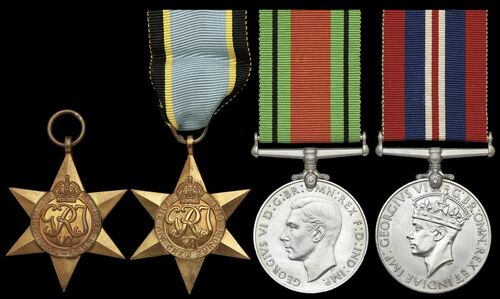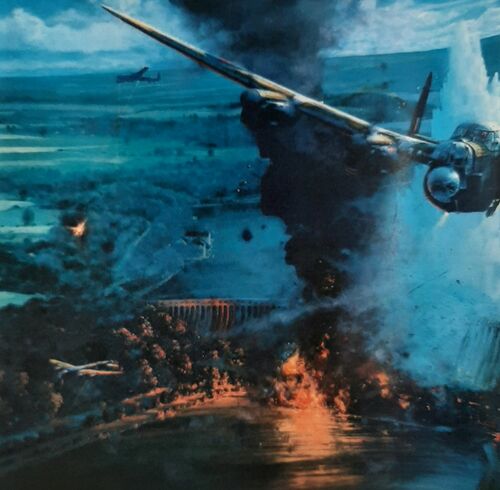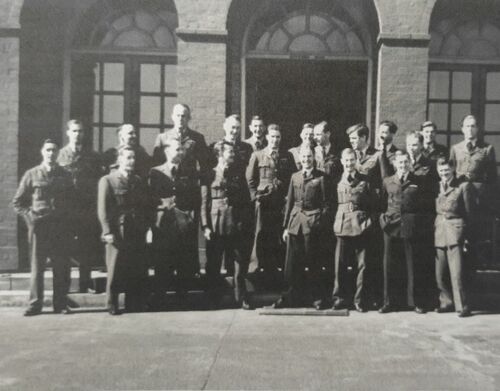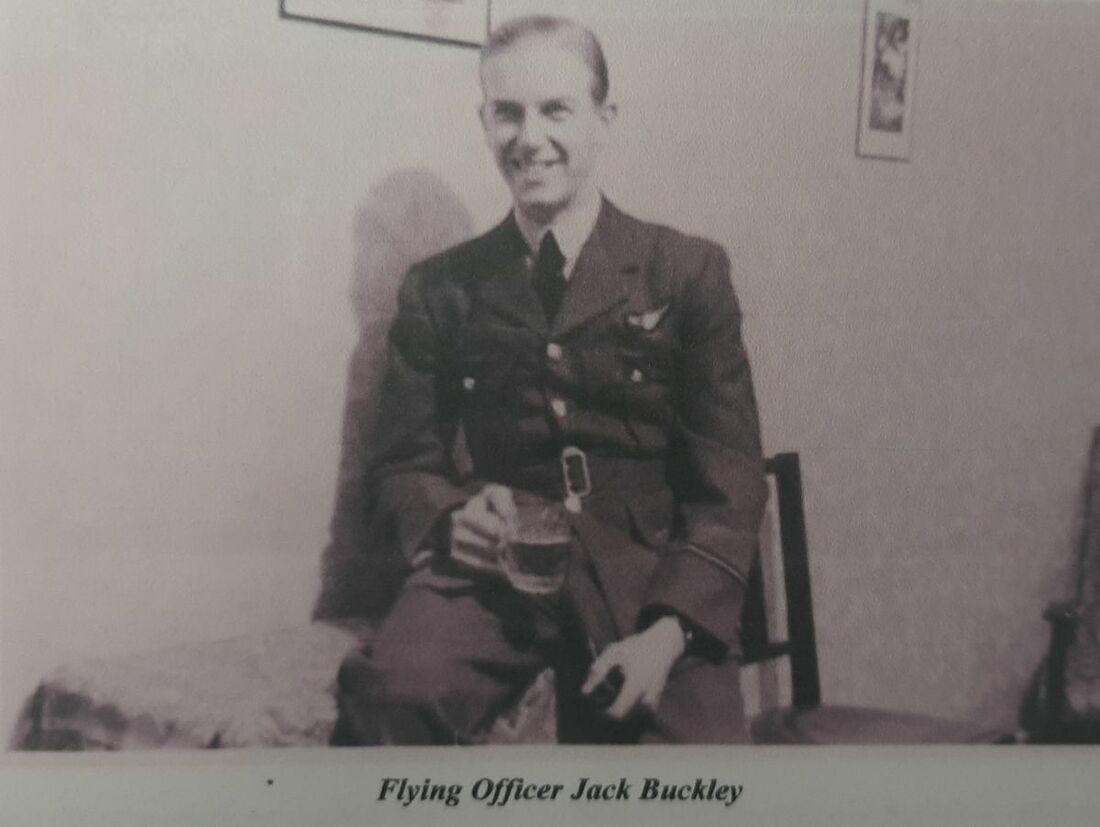Auction: 23003 - Orders, Decorations and Medals
Lot: 105
'Gibson ordered Shannon to go first. Even trying a dummy run was going to be dangerous enough, because even the slightest misjudgement of the approach could prove fatal. With the town of Waldeck, behind the castle, as his start point, Shannon dived down the gorge towards the lake, then with the tip of the spit as his marker, made a left turn through ninety degrees, levelled out, tried to get to sixty feet and with just 450 yards to go, should have been in position drop the Upkeep. He was not, however he was still too high. Thundering over the dam wall, he put on full throttle and carried out a steep climbing turn to the right to avoid smacking into the rock face beyond. Watching from above, Gibson saw sparks from the engines on Shannon's plane as it lurched up out of the fray. "To exit from the Eder Dam", says Shannon, "with a 9,000lb mine revolving at 500 revs was fairly hairy." Having eventually cleared the hill, he banked away to the left and in a wide arc, swept around for another attempt.'
(Flight Lieutenant David Shannon's hair raising first run at the Eder Dam on the night of 16 May 1943, Dam Busters: The Race to Smash the Dams, 1943, by James Holland, refers)
A superb 'Operation Chastise 1943' D.F.C. winner's Campaign group of four awarded to Squadron Leader J. Buckley, 617 Squadron, Royal Air Force Volunteer Reserve, a Dambuster who took part in the legendary raid in Lancaster L-Leather under the command of David Shannon
1939-45 Star; Air Crew Europe Star; Defence and War Medals 1939-45, with box of issue named to 'Mr. J. Buckley, D.F.C.', and relevant 'ticker tape' serial number slip, good very fine (4)
[D.F.C.] London Gazette 28 May 1943:
'On the night of 16th May, 1943, a force of Lancaster bombers was detailed to attack the Mohne, Eder and Sorpe dams in Germany. The operation was one of great difficulty and hazard, demanding a high degree of skill and courage and close co-operation between the crews of the aircraft engaged. Nevertheless, a telling blow was struck at the enemy by the successful breaching of the Möhne and Eder dams. This outstanding success reflects the greatest credit on the efforts of the following personnel who participated in the operation in various capacities as members of the aircraft crew.'
Note, one of 10 first awards of the D.F.C. for the raid.
Jack Buckley was born at Bradford on 1 May 1919, son of Hubert and Lucy Buckley of Shipley, Yorkshire, attending Salt's High School, Saltaire. He joined the Royal Air Force Volunteer Reserve early in the war before being posted as a Flight Sergeant to No. 75 (New Zealand) Squadron. Serving there as an Air Gunner he flew thirty-five operations with the unit before being Commissioned Pilot-Officer on 6 June 1942. Posted to No. 10 Operational Training Unit with this rank he was advanced Flying Officer on 6 December 1942. Buckley was to serve there until he joined 617 Squadron on 11 April 1943.
One of the most experienced Air Gunners in the Squadron Buckley was assigned to the Australian David Shannon's crew. He quickly became heavily involved in the Squadrons social life as well, being well known for his heavy drinking and love of racing, bomber aimer and fellow crewmate Len Sumpter noted that he owned a racing car. Just one month his arrival the crews of 617 Squadron would find themselves preparing for one of the most audacious raids ever undertaken.
The approach to the Rhur Valley was made low and 617 Squadron encountered far more flak than expected, taking heavy losses as a result. These losses were not improved at the Möhne Dam which claimed 'Hoppy' Hopgood's Lancaster however a successful breach here soon proved the theory and the formation raced on to the less well defended Eder. It was here that Shannon's Lancaster made repeated runs like the one described above, trying to get a bead on the difficult target. The next minutes are well outlined in Breaking The German Dams; A Minute-By-Minute Account of Operation Chastise, May 1943 by Robert Owen, which states:
'Accounts of events on the Eder vary. Having told Shannon to hold off, Gibson then called in Squadron Leader Henry Maudslay. Maudslay may then have made two attempts before Shannon tried again, trying a new line of approach. This seems to have tried to avoid crossing over the Hammerberg spit, but instead passing close to its tip. While this made it easier to achieve the desired height and speed, it did not guarantee an accurate 90-degree line of approach to the centre of the dam wall. It seems that Shannon made two further runs of this nature, releasing on the second. As his bomb aimer, F/Sgt Len Sumpter, called "Bombs gone" Henderson applied full power and Shannon hauled the Lancaster up and round, the approaching slope of the Michelskopf illuminated in the beam of the landing light which he had switched on as a further aid.
Whether as a result of taking a deliberate line to starboard, or not being able to tighten his turn sufficiently to line up on the centre dam between the towers, Shannon's final run released "Upkeep" on a heading of 150 degrees - some 30 degrees to starboard off a direct line. The "Upkeep" was seen to bounce twice, suggesting release at a range less than 450 yards before striking the dam and glancing off at an angle. It then continued to run into the shallow water at the southern end of the dam - seemingly between the bank and the southern tower where it detonated with the usual plume of water, this time interspersed with mud and debris.
Gibson and Knight, who witnessed the run, did not report any visible damage to the dam, but according to Shannon, he saw a hole appear about 9 feet wide below the level of the parapet. This does not accord with any other report. At the time of the attack the lake was over topping the upper spillways and it is possible that he mistook this or water running past one of the main sluice openings lower down the wall.'
L-Leather continued to circle as repeated runs were made and finally it was Knight's N-Nuts that made the telling blow, landing an 'Upkeep' perfectly at the dam wall. In Shannon's aircraft it was Buckley, tail end Charlie, who saw the destruction first:
'In Shannon's aircraft, bomb aimer Len Sumpter, first heard "a hell of a bang" and then their Yorkshire rear gunner, Jack Buckley, who was in a position to see the dam, shouted: "It's gone!"'
(IBED)
As the reserve moved in to attack the remaining dam, Shannon made for Britain and landed at Scampton at 04:06 on 17 May. Buckley appeared in the Officer's Mess photo the next day standing between his Captain of Aircraft, David Shannon and Leslie Knight, whose bomb brought down the Eder Dam. Despite their obvious elation at the success of the raid the cost was high, eight aircraft had failed to return and in total 56 crew.
Buckley remained with the Squadron and flew several more Ops with Shannon, being advance Flight Lieutenant after the raid. He returned to a training unit the year after the raid in the summer of 1944, around the same time he was further advanced Squadron Leader on 6 June 1944. Still serving there on the end of the war, Buckley returned to his pre-war occupation in the wool trade in Bradford after hostilities ceased and died there on 6 May 1990; sold together with copied research including census data, London Gazette extracts and a list of aircraft and crew who took part in Operation Chastise along with a large number of articles and blog posts relating to the raid.
Subject to 20% VAT on Buyer’s Premium. For more information please view Terms and Conditions for Buyers.
Sold for
£8,500
Starting price
£3200













